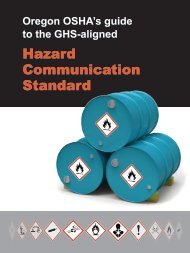Technical Manual - Section 3 (Safety Hazards)
Technical Manual - Section 3 (Safety Hazards)
Technical Manual - Section 3 (Safety Hazards)
Create successful ePaper yourself
Turn your PDF publications into a flip-book with our unique Google optimized e-Paper software.
Figure II:2-7 Electrostatic Desalting<br />
condensed water, can cause corrosion. Overpressuring the<br />
unit is another potential hazard that causes failures.<br />
Health<br />
Because this is a closed process, there is little potential for<br />
exposure to crude oil unless a leak or release occurs. Where<br />
elevated operating temperatures are used when desalting sour<br />
crudes, hydrogen sulfide will be present. There is the<br />
possibility of exposure to ammonia, dry chemical<br />
demulsifiers, caustics, and/or acids during this operation. Safe<br />
work practices and/or the use of appropriate personal<br />
protective equipment may be needed for exposures to<br />
chemicals and other hazards such as heat, and during process<br />
sampling, inspection, maintenance, and turnaround activities.<br />
Depending on the crude feedstock and the treatment<br />
chemicals used, the wastewater will contain varying amounts<br />
of chlorides, sulfides, bicarbonates, ammonia, hydrocarbons,<br />
phenol, and suspended solids. If diatomaceous earth is used<br />
in filtration, exposures should be minimized or controlled.<br />
Diatomaceous earth can contain silica in very fine particle<br />
size, making this a potential respiratory hazard.<br />
III:2-16
















